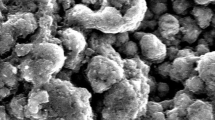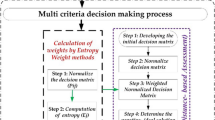Abstract
This study has been carried out to assess the impact of electrical discharge machining parameters on the SiC-reinforced aluminum metal matrix composites. The criteria in machining process including electrodes material, current, pulse time, and dielectric medium were diversified to evaluate their effect on material removal rate (MRR), surface roughness (SR), and residual stresses. The residual stresses induced due to subsequent heating and cooling shocks during the electric discharge process are of primary concern while machining process. The magnitude of residual stresses induced on the machined surface was estimated via X-ray diffraction method. The process conditions that influenced the responses were recognized and optimized synchronically using multiple criteria decision-making and statistical techniques. In this study, analytical hierarchy process (AHP) and a multi-objective optimization analysis (MOORA) will solve process condition problem. This approach confers the combination of process parameter settings suitable for the machining of such composites.
Access this chapter
Tax calculation will be finalised at checkout
Purchases are for personal use only
Similar content being viewed by others
References
Callister WD (2004) Composites. Materials science and engineering an introduction, 6th edn. Wiley, New York, pp 527–560
Ahamed AR, Asokan P, Aravindan S (2009) EDM of hybrid Al–SiCp–B4Cp and Al–SiCp–Glassp MMCs. Int J Adv Manuf Technol 44(5–6):520–528
Bains PS, Sidhu SS, Payal HS (2016) Fabrication and machining of metal matrix composites: a review. Mater Manuf Processes 31(5):553–573
Schachra A, Lenz E (1976) LBM and EDM—a comparison on crack behavior. Ann CIRP 25:121–123
Sidhu SS, Batish A, Kumar S (2014) Study of surface properties in particulate-reinforced metal matrix composites (MMCs) using powder-mixed electrical discharge machining (EDM). Mater Manuf Process 29(1):46–52
Feng X, Wong YS, Hong GS (2016) Characterization and geometric modeling of single and overlapping craters in micro-EDM. Mach Sci Technol Int J 20(1):79–98
Gill AS, Kumar S (2016) Surface roughness and microhardness evaluation for EDM with Cu–Mn powder metallurgy tool. Mater Manuf Processes 31(4):514–521
Pal VK, Choudhury SK (2016) Fabrication and analysis of complex-shape tool for EDM by AWJM process. Adv Mater Process Technol 1(3–4):444–452
Hocheng H, Lei WT, Hsu HS (1997) Preliminary study of material removal in electrical-discharge machining of SiC/Al. J Mater Process Technol 63(1):813–818
Singh PN, Raghukandan K, Pai BC (2004) Optimization by grey relational analysis of EDM parameters on machining Al–10% SiC P composites. J Mater Process Technol 155:1658–1661
Garg RK, Singh KK, Sachdeva A, Sharma VS, Ojha K, Singh S (2010) Review of research work in sinking EDM and WEDM on metal matrix composite materials. Int J Adv Manuf Technol 50(5–8):611–624
Majumder A, Das PK, Majumder A, Debnath M (2014) An approach to optimize the EDM process parameters using desirability-based multi-objective PSO. Prod Manuf Res 2(1):228–240
Singh PN, Raghukandan K, Rathinasabapathi M, Pai BC (2004) Electric discharge machining of Al–10% SiC p as-cast metal matrix composites. J Mater Process Technol 155:1653–1657
Kuriakose S, Shunmugam MS (2005) Multi-objective optimization of wire-electro discharge machining process by non-dominated sorting genetic algorithm. J Mater Process Technol 170(1):133–141
Tzeng YF, Chen FC (2007) Multi-objective optimisation of high-speed electrical discharge machining process using a Taguchi fuzzy-based approach. Mater Des 28(4):1159–1168
Sidhu SS, Batish A, Kumar S (2013) EDM of metal matrix composite for parameter design using lexicographic goal programming. Mater Manuf Processes 28(4):495–500
Withers PJ, Bhadeshia HKDH (2001) Residual stress. Part 1–measurement techniques. Mater Sci Technol 17(4):355–365
Sidhu SS, Batish A, Kumar S (2013) Fabrication and electrical discharge machining of metal–matrix composites: a review. J Reinf Plast Compos 32(17):1310–1320
Kalibatas D, Turskis Z (2008) Multicriteria evaluation of inner climate by using MOORA method. Inf Technol Control 37:79–83
Akkaya G, Turanoğlu B, Öztaş S (2015) An integrated fuzzy AHP and fuzzy MOORA approach to the problem of industrial engineering sector choosing. Expert Syst Appl 42(24):9565–9573
Chakraborty S (2011) Applications of the MOORA method for decision making in manufacturing environment. Int J Adv Manuf Technol 54(9–12):1155–1166
Das MC, Sarkar B, Ray S (2012) Comparative evaluation of Indian technical institutions using fuzzy AHP and MOORA. Int J Multicriteria Decis Making 2(1):74–93
Saaty TL (1977) A scaling method for priorities in hierarchical structures. J Math Psychol 15(3):234–281
Saaty TL (1988) What is the analytic hierarchy process?. Springer, Berlin, pp 109–121
Amiri MP (2010) Project selection for oil-fields development by using the AHP and fuzzy TOPSIS methods. Expert Syst Appl 37(9):6218–6224
Triantaphyllou E (2000) Multi-criteria decision making methods: a comparative study. Springer, US, pp 5–21
Brauers WKM, Zavadskas EK (2006) The MOORA method and its application to privatization in a transition economy. Control Cybern 35(2):445
Zavadskas EK, Turskis Z, Kildienė S (2014) State of art surveys of overviews on MCDM/MADM methods. Technol Econ Dev Econ 20(1):165–179
Balezentis T, Balezentis A (2014) A survey on development and applications of the multi-criteria decision making method MULTIMOORA. J Multi-Criteria Decis Anal 21(3–4):209–222
Stanujkic D (2016) An extension of the ratio system approach of MOORA method for group decision-making based on interval-valued triangular fuzzy numbers. Technol Econ Dev Econ 22(1):122–141
Brauers WKM, Ginevičius R, Podvezko V (2010) Regional development in Lithuania considering multiple objectives by the MOORA method. Technol Econ Dev Econ 16(4):613–640
Karande P, Chakraborty S (2012) Application of multi-objective optimization on the basis of ratio analysis (MOORA) method for materials selection. Mater Des 37:317–324
Lazauskas M et al (2015) Multicriteria assessment of unfinished construction projects. Gradevinar 67(4):319–328
Ross PJ (1998) Taguchi techniques for quality engineering. McGraw Hill Book Company, New York, p 228
Sidhu SS, Batish A, Kumar S (2015) Analysis of residual stresses in particulate reinforced aluminum matrix composite after EDM. J Mater Sci Technol 31(15):1850–1859
Welzel U, Ligot J, Lamparter P, Vermeulen AC, Mittemeijer EJ (2005) Stress analysis of polycrystalline thin films and surface regions by X-ray diffraction. J Appl Crystallogr 38(1):1–29
Saaty TL (2001) Fundamentals of the analytic hierarchy process. Springer, Netherlands, pp 15–35
Al-Harbi KMAS (2001) Application of the AHP in project management. Int J Project Manage 19(1):19–27
Whitaker R (2007) Validation examples of the analytic hierarchy process and analytic network process. Math Comput Model 46(7):840–859
Taha AH (2008) Decision analysis and games. Operation research an introduction, 9th edn. Pearson education, India, pp 503–511
Author information
Authors and Affiliations
Corresponding author
Editor information
Editors and Affiliations
Rights and permissions
Copyright information
© 2018 Springer Nature Singapore Pte Ltd.
About this chapter
Cite this chapter
Sidhu, S.S., Bains, P.S., Yazdani, M., Zolfaniab, S.H. (2018). Application of MCDM Techniques on Nonconventional Machining of Composites. In: Sidhu, S., Bains, P., Zitoune, R., Yazdani, M. (eds) Futuristic Composites . Materials Horizons: From Nature to Nanomaterials. Springer, Singapore. https://doi.org/10.1007/978-981-13-2417-8_6
Download citation
DOI: https://doi.org/10.1007/978-981-13-2417-8_6
Published:
Publisher Name: Springer, Singapore
Print ISBN: 978-981-13-2416-1
Online ISBN: 978-981-13-2417-8
eBook Packages: Chemistry and Materials ScienceChemistry and Material Science (R0)




